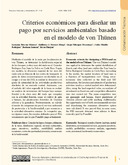| dc.contributor.author | Pitacuar Meneses, M. Lixmania | |
| dc.contributor.author | Navarro, Guillermo A. | |
| dc.contributor.author | Velásquez Mazariegos, Sergio | |
| dc.contributor.author | Murillo Rodríguez, Carlos | |
| dc.contributor.author | Finegan, Bryan | |
| dc.date.accessioned | 2016-01-21T17:18:59Z | |
| dc.date.available | 2016-01-21T17:18:59Z | |
| dc.date.issued | 2012 | |
| dc.identifier.issn | 1659-1216 | es_EN |
| dc.identifier.issn | CATIE | es_ES |
| dc.identifier.uri | https://repositorio.catie.ac.cr/handle/11554/8142 | |
| dc.description.abstract | Mediante el modelo de la renta por localización de von Thünen, se determinó la distribución espacial de los bosques y otros usos del suelo en el Corredor Biológico San Juan La Selva en Costa Rica. Según ese modelo, la ubicación espacial de los usos del suelo está en función de los costos de transporte. A partir de datos socioeconómicos recolectados en el campo y el uso del SIG, se analizó la ubicación y el grado de intensidad de las actividades productivas alrededor de un mercado central. Asimismo, con el método del valor esperado de la tierra se realizó un análisis de inversiones del bosque bajo manejo forestal y de otros usos del suelo que compiten con la actividad forestal, como el cultivo de piña y banano, las plantaciones forestales de Gmelina arborea y la ganadería. Posteriormente, se calculó el monto de compensación por el servicio ambiental de protección a la biodiversidad y por renunciar a la actividad alternativa mínima. Se comprobó que, en algunos casos, los montos definidos para el PSA son menores que lo que Fonafifo paga actualmente. | es_ES |
| dc.description.abstract | The von Thünen’s model was applied to determine the spatial distribution of forests and other land uses within the San Juan La Selva Biological Corridor in Costa Rica. According to the model, the spatial location of land uses is a function of transportation cost. Using socio-economic data collected in the field and GIS information, the location and intensity of production activities nearby a central market were determined. Also, using the land expected value, an analysis of investment on forest use and competitive alternative uses was carried out. The main competitive uses are pineapple and banana, forest plantations of Gmelina arborea and cattle ranching. Additionally, the opportunity cost of both environmental services and abandoning the minimum alternative option were calculated. It was proved that, in some cases, the PES amounts obtained were inferior to those currently paid by Fonafifo. | en_EN |
| dc.format.mimetype | pdf | |
| dc.language.iso | es | es_ES |
| dc.publisher | CATIE, Turrialba (Costa Rica) | |
| dc.relation.ispartof | Recursos Naturales y Ambiente; Número 67, páginas 1-19 | |
| dc.rights.uri | https://creativecommons.org/licenses/by-nc-nd/4.0/ | |
| dc.subject | ANALISIS ECONOMICO | es_ES |
| dc.subject | COSTOS DE OPORTUNIDAD | es_ES |
| dc.subject | INVERSIONES | es_ES |
| dc.subject | UTILIZACIÓN DE LA TIERRA | es_ES |
| dc.subject | DISTRIBUCIÓN ESPACIAL | es_ES |
| dc.subject | MODELOS | es_ES |
| dc.subject | RENTABILIDAD | es_ES |
| dc.subject | INCENTIVOS | es_ES |
| dc.subject | CONSERVACIÓN DE LA DIVERSIDAD BIOLOGICA | es_ES |
| dc.title | Criterios económicos para diseñar un pago por servicios ambientales basado en el modelo de von Thünen | es_ES |
| dc.title.alternative | Economic criteria for designing a PES based on the model of von Thünen | en_EN |
| dc.type | Artículo | es_ES |
| dc.identifier.publication | CATIE | es_ES |
| dc.journal.issueNumber | 67 | |
| dc.journal.pages | 1-19 | |



